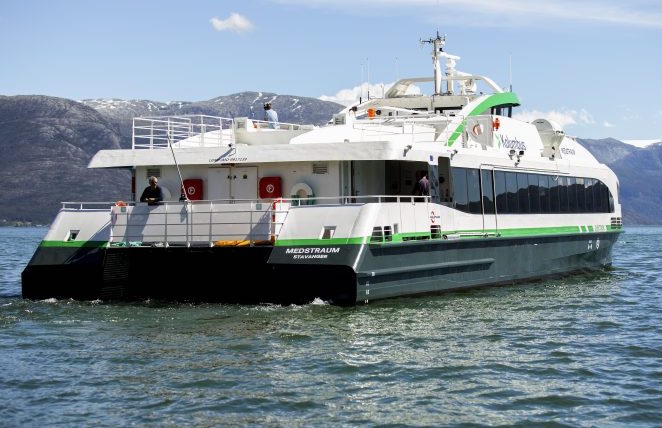(STAVANGER, Norway) — Medstraum, the world’s first fully electric and zero-emission fast ferry, classed as a high-speed craft, embarked this week on the journey from Fjellstrand shipyard in Norway to its new home port, Stavanger.
The vessel has been built using unique modular manufacturing methods at Fjellstrand. Modularization helps cut both production costs and engineering costs and will contribute to making electric-powered high-speed vessels competitive in terms of both cost and the environment. Medstraum will vastly improve the carbon footprint of its owners, Kolumbus, a public transport company.

“We are very happy to finally get this flagship delivered. Kolumbus aims to be at the forefront of adopting new and environmentally technology,” said Mikal Dahle, project manager at Kolumbus. The company currently has 10 fast ferries, some traditional propulsion ferries, and 450 buses in operation.
“Medstraum will cut our emissions by 1,500 tonnes a year, despite operating on our least energy-demanding route. That’s the equivalent of 60 buses,” Dahle said. In late summer, the vessel will welcome passengers for scheduled operations between Stavanger and Homersak.
“It’s been challenging building this ship, as it’s never been done before, but we’ve learned a lot,” said Edmund Tolo, head of research and development at Fjellstrand AS. “Fast ferries require a lot of energy, so we needed to make Medstraum lighter and a lot more efficient than traditional fast ferries. We’re very happy and proud to have accomplished that. It is revolutionary that a vessel of this size can operate at 23 knots for an entire hour by electricity alone.”
In 2015, the world’s first fully electric ferry, Ampere, was built at the Fjellstrand shipyard in Hardanger, Norway. That marked the start of an electric revolution on Norwegian ferries. Now, only seven years later, there are approximately 70 emission-free ferries operating in Norway.
“Medstraum is already stirring great interest internationally. The maritime industry across the world is now looking at what we achieve in our maritime cluster,” said Hege Okland, CEO of Maritime CleanTech, the cluster organization that initiated and established the European Union-funded TrAM-project, which resulted in Medstraum. “This could really be the start of a new adventure for our industry. Not only have the project partners developed and demonstrated a new and emission-free propulsion system that can maintain higher speeds than before, we have also adopted completely new modular design and construction methods that will revolutionize the way we build boats in the future.
“The modular way of thinking is absolutely central to the project,” Okland said. “This means that ships can be purpose-built by putting together finished modules, which can be built in different places. This will save both time and money in the design and construction phase. It will also make it easier to get more boats into the market faster. This way, we can reach future emission requirements faster, by replacing fossil fast ferries with electric ones like Medstraum.”
Medstraum specifications
Cruising speed during operation: 23 knots
Maximum speed: 27 knots
Length: 98.5 feet
Width: 29.6 feet
Battery capacity: 1,524 kWh (Corvus Energy)
Electric engines: (2) 550 kW
Charge capacity: 2.3 MW
This pilot vessel is a result of the EU-funded TrAM-project and is partly funded by Rogaland County Council.
Project partners: Maritime CleanTech (Norway), Kolumbus (Norway), Rogaland County Council (Norway), Fjellstrand (Norway), Leirvik (Norway), Hydro (Norway), Servogear (Norway), Wartsila (Norway), HSVA (Norway), University of Strathclyde (Great Britain), National Technical University of Athens (Greece), Fraunhofer IEM (Germany), Uber Boat by Thames Clippers (Great Britain) and De Vlaamse Waterweg (Netherlands).
– Maritime CleanTech
